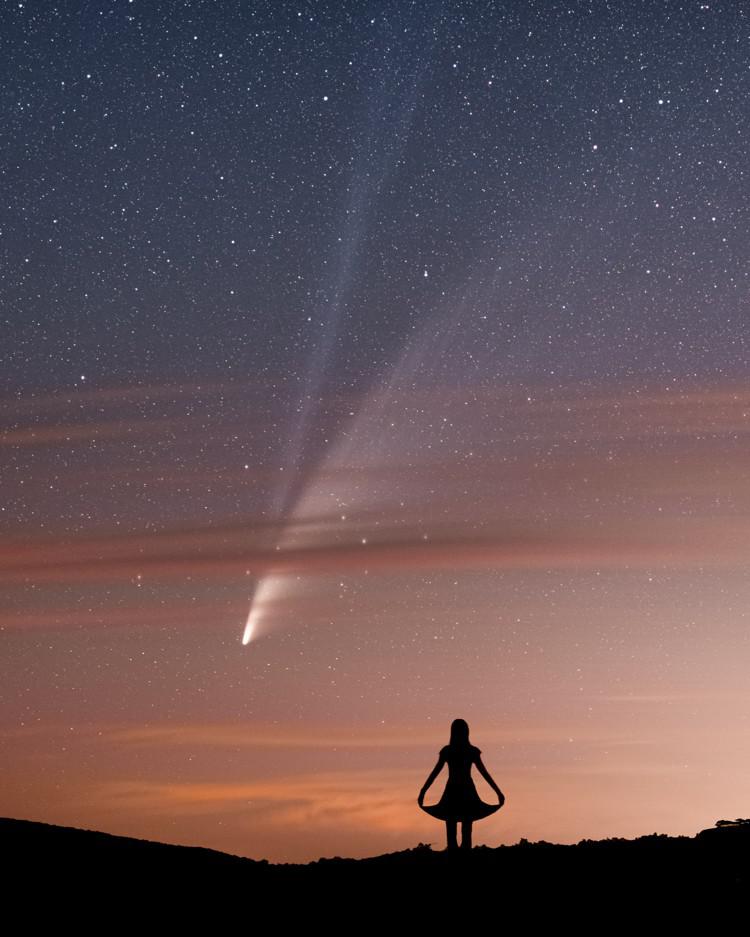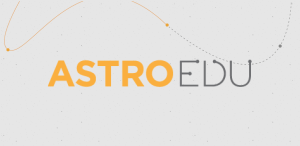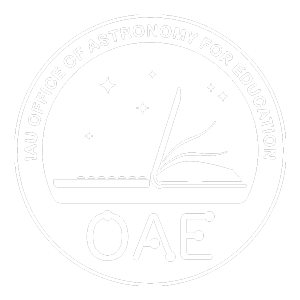This page describes an image Hello Comet, shall we dance?, by Robert Barsa, Slovakia
Image caption:
Third place in the 2021 IAU OAE Astrophotography Contest, category Comets.
This beautiful and poetic image taken from Slovakia in July 2020 captures the comet C/2020 F3 (Neowise). The direction of the tails of the comet provides a clue as to the position of the Sun. In the past, the appearance of a comet in the skies could be accompanied by apprehension and even fear from those who did not know what these objects really are. Through careful observations and the applications of knowledge from physics, chemistry and geology, we now understand that comets are objects left over from the earliest days when the Solar System formed. The most distinctive features of a comet are the bluish ion (gas) tail, and whitish dust tail, which can extend for tens of millions of kilometres. These distinctive features, easily observable with the unaided eye together with an understanding of the science, are no longer cause for fear, rather they help us understand the history of our Solar System, and bring awe, joy and contemplation, as portrayed in this image.
Scroll to captions in other languages
Image credit:
Robert Barsa/IAU OAE
DOI: 10.5281/zenodo.5290650
Related glossary terms:
Comet
, Cometary Tail
Categories:
Naked Eye Astronomy
, Solar System
Image license: Creative Commons Attribution 4.0 International (CC BY 4.0) Creative Commons Attribution 4.0 International (CC BY 4.0) icons
The media file captions presented on the OAE website were written, translated and reviewed by a collective effort from the OAE, the OAE Centers and Nodes, the OAE National Astronomy Education Coordinators (NAECs) and other volunteers. You can find a full list of credits for our translation project here. All media file captions are released under a Creative Commons CC BY-4.0 license and should be credited to "IAU OAE". The media files themselves may have different licenses (see above) and should be credited as listed above under "credit".
If you notice a factual error in this caption or an error in any of its translations then please get in touch.
Captions in Different Languages:
Image caption: ২০২১ আইএইউ ওএইঅ্যাস্ট্রোফটোগ্রাফি প্রতিযোগিতায় তৃতীয় স্থান, ধূমকেতু বিভাগে।
২০২০ সালের জুলাই মাসে স্লোভাকিয়া থেকে তোলা এই সুন্দর এবং কাব্যিক চিত্রটি ধূমকেতু সি/২০২০ এফ৩ (নিওয়াইজ) ক্যাপচার করে। ধূমকেতুর লেজের দিক সূর্যের অবস্থান সম্পর্কে একটি সূত্র প্রদান করে। অতীতে, আকাশে ধূমকেতুর আবির্ভাব শঙ্কা এবং এমনকি যারা এই বস্তুগুলি আসলে কী তা জানত না তাদের কাছ থেকে ভয়ও হতে পারে। সতর্ক পর্যবেক্ষণ এবং পদার্থবিদ্যা, রসায়ন এবং ভূতত্ত্ব থেকে জ্ঞানের প্রয়োগের মাধ্যমে, আমরা এখন বুঝতে পারি যে ধূমকেতু হল সৌরজগতের প্রথম দিন থেকে অবশিষ্ট বস্তু। ধূমকেতুর সবচেয়ে স্বতন্ত্র বৈশিষ্ট্য হল নীলাভ আয়ন (গ্যাস) লেজ এবং সাদা ধূলিকণার লেজ, যা লক্ষ লক্ষ কিলোমিটার পর্যন্ত বিস্তৃত হতে পারে। এই স্বাতন্ত্র্যসূচক বৈশিষ্ট্যগুলি, বিজ্ঞানের বোঝার সাথে একত্রে সাহায্যবিহীন চোখ দিয়ে সহজেই পর্যবেক্ষণ করা যায়, এখন আর ভয়ের কারণ নয়, বরং তারা আমাদের সৌরজগতের ইতিহাস বুঝতে সাহায্য করে এবং এই ছবিতে চিত্রিত হিসাবে বিস্ময়, আনন্দ এবং মনন নিয়ে আসে .
Image credit: রবার্ট বারসা /আইএইউ ওএই
Related glossary terms: Comet , Cometary Tail Caption translation status: Not yet approved by a reviewer
Caption translators: Raktim Mukherjee
Image caption: Terzo posto al Concorso Astrofotografico IAU OAE 2021, categoria Comete.
Questa bella e poetica immagine ripresa dalla Slovacchia nel luglio 2020 cattura la cometa C/2020 F3 (Neowise). La direzione delle code della cometa fornisce un indizio sulla posizione del Sole. In passato, l'apparizione di una cometa nei cieli poteva essere accompagnata da apprensione e persino paura da parte di chi non sapeva cosa fossero realmente questi oggetti. Grazie ad attente osservazioni e all'applicazione delle conoscenze di fisica, chimica e geologia, oggi sappiamo che le comete sono oggetti che risalgono ai primi tempi della formazione del Sistema Solare. Le caratteristiche più distintive di una cometa sono la coda bluastra di ioni (gas) e la coda biancastra di polvere, che può estendersi per decine di milioni di chilometri. Queste caratteristiche peculiari, facilmente osservabili a occhio nudo e con una buona conoscenza della scienza, non sono più motivo di paura, ma piuttosto ci aiutano a comprendere la storia del nostro Sistema Solare e ci suscitano stupore, gioia e contemplazione, come mostra questa immagine.
Image credit: Robert Barsa/IAU OAE
Related glossary terms: Coda cometaria , Cometa Caption translation status: Approved by a reviewer
Caption translators: Giuliana Giobbi
Caption reviewers: Rodolfo Canestrari
Image caption: 2021年国际天文学联合会教育办公室天文摄影大赛彗星类别季军作品。
这张优美而富有诗意的照片拍摄于2020年7月来自斯洛伐克,记录了彗星C/2020 F3(NEOWISE)的身影。彗星尾巴的方向为太阳的位置提供了线索。在过去,对于不了解这些天体本质的人来说,天空中彗星的出现常常会让他们感到忧虑甚至恐惧。然而,通过细致的观测以及物理学、化学和地质学知识,我们如今了解到,彗星是太阳系形成早期残留的天体。彗星最显著的特征是蓝色的离子(气体)尾和白色的尘埃尾,这些尾巴可以延伸数千万公里。这些独特的特征,即便肉眼也能轻松观测到,再加上科学的理解,不再会引起恐惧,而是帮助我们探索太阳系的历史,带来敬畏、喜悦和思索,正如这幅影像中所呈现的那样。
Image credit: 罗伯特·巴尔萨/国际天文学联合会教育办公室
Related glossary terms: 彗尾 , 彗星 Caption translation status: Not yet approved by a reviewer
Caption translators: Li Jiankang
Image caption: 2021年國際天文學聯合會教育辦公室天文攝影大賽彗星類別季軍作品。
這張優美而富有詩意的照片拍攝於2020年7月來自斯洛伐克,記錄了彗星C/2020 F3(NEOWISE)的身影。彗星尾巴的方向為太陽的位置提供了線索。在過去,對於不了解這些天體本質的人來說,天空中彗星的出現常常會讓他們感到憂慮甚至恐懼。然而,通過細緻的觀測以及物理學、化學和地質學知識,我們如今了解到,彗星是太陽系形成早期殘留的天體。彗星最顯著的特徵是藍色的離子(氣體)尾和白色的塵埃尾,這些尾巴可以延伸數千萬公里。這些獨特的特徵,即便肉眼也能輕鬆觀測到,再加上科學的理解,不再會引起恐懼,而是幫助我們探索太陽系的歷史,帶來敬畏、喜悅和思索,正如這幅影像中所呈現的那樣。
Image credit: 羅伯特·巴爾薩/國際天文學聯合會教育辦公室
Related glossary terms: 彗尾 , 彗星 Caption translation status: Not yet approved by a reviewer
Caption translators: An automated transliteration from the simplified Chinese translation by - Li Jiankang









